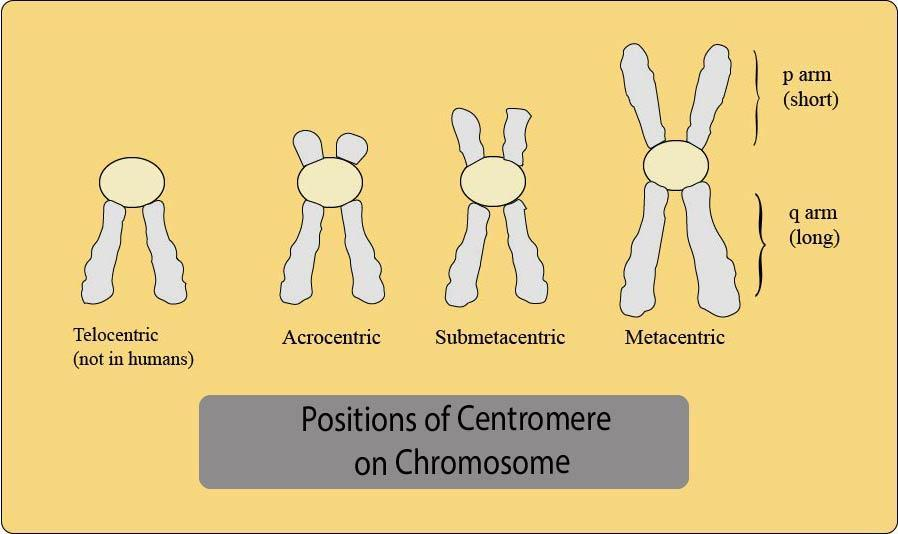
One type of chromosome has a middle centromere whereas the other has a terminal centromere. They are
(a) Metacentric and acrocentric
(b) Metacentric and telocentric
(c) Sub Metacentric and telocentric
(d) Acrocentric and metacentric
Answer
501.9k+ views
Hint: Basically, these names are given to the chromosomes according to their position of the centromere. They may be of shape due to their position like X shaped, I shaped, J shaped.
Complete answer:
We know that chromosomes are located inside the nucleus of animal and plant cells and they are thread-like in structure and they are made of protein and a single molecule of deoxyribonucleic acid (DNA). The specialized DNA sequence of a chromosome that joins a pair of sister chromatids (a dyad) is the centromere. During the mitosis division, the spindle fibers attach to the centromere via the kinetochore. At first, centromeres were thought to be genetic loci that direct the behavior of chromosomes. According to the location of the centromere, the chromosomes are classified as metacentric, submetacentric, acrocentric, and telocentric.
Metacentric:
These are chromosomes having X-shape, with the centromere in the middle so that the two arms of the chromosomes are almost equal.
Submetacentric:
The submetacentric chromosome has unequal arms. They are L-shaped.
Acrocentric:
If the short arm i.e the p arm is so short that it is hard to observe, but still present, then the chromosome is said as acrocentric (the "acro-" in acrocentric refers to the Greek word for "peak") .
Telocentric:
In a telocentric chromosome, the centromere is located at the terminal end of the chromosome. A telocentric chromosome has therefore only one arm. Telomeres may extend from both ends of the chromosome, their shape is similar to the letter "i" during anaphase.

So, the correct answer is, ‘(b) Metacentric and telocentric’.
Additional Information:
1) Five chromosomes are considered to be metacentric in a normal human karyotype. Those are chromosomes no 1, 3, 16, 19, 20, and X.
2) Human chromosomes 4 through 12 are submetacentric.
3) The human genome includes five acrocentric chromosomes: 13, 14, 15, 21, 22. The Y chromosome is also acrocentric.
4) Humans do not possess telocentric chromosomes.
Note: Centromeres have specialized zones called kinetochores attach the chromosomes to spindle fibers in prophase in mitosis. The kinetochores possess protein complexes that generate kinetochore fibers. During the cell division, these fibers help to orient and separate the chromosomes. In metaphase-I of meiosis I, the centromeres of homologous chromosomes are oriented toward opposite cell poles while in the case of meiosis II, spindle fibers extending from both cell poles attach to sister chromatids at their centromeres. The shape of the chromosomes is visible in the anaphase stage.
Complete answer:
We know that chromosomes are located inside the nucleus of animal and plant cells and they are thread-like in structure and they are made of protein and a single molecule of deoxyribonucleic acid (DNA). The specialized DNA sequence of a chromosome that joins a pair of sister chromatids (a dyad) is the centromere. During the mitosis division, the spindle fibers attach to the centromere via the kinetochore. At first, centromeres were thought to be genetic loci that direct the behavior of chromosomes. According to the location of the centromere, the chromosomes are classified as metacentric, submetacentric, acrocentric, and telocentric.
Metacentric:
These are chromosomes having X-shape, with the centromere in the middle so that the two arms of the chromosomes are almost equal.
Submetacentric:
The submetacentric chromosome has unequal arms. They are L-shaped.
Acrocentric:
If the short arm i.e the p arm is so short that it is hard to observe, but still present, then the chromosome is said as acrocentric (the "acro-" in acrocentric refers to the Greek word for "peak") .
Telocentric:
In a telocentric chromosome, the centromere is located at the terminal end of the chromosome. A telocentric chromosome has therefore only one arm. Telomeres may extend from both ends of the chromosome, their shape is similar to the letter "i" during anaphase.

So, the correct answer is, ‘(b) Metacentric and telocentric’.
Additional Information:
1) Five chromosomes are considered to be metacentric in a normal human karyotype. Those are chromosomes no 1, 3, 16, 19, 20, and X.
2) Human chromosomes 4 through 12 are submetacentric.
3) The human genome includes five acrocentric chromosomes: 13, 14, 15, 21, 22. The Y chromosome is also acrocentric.
4) Humans do not possess telocentric chromosomes.
Note: Centromeres have specialized zones called kinetochores attach the chromosomes to spindle fibers in prophase in mitosis. The kinetochores possess protein complexes that generate kinetochore fibers. During the cell division, these fibers help to orient and separate the chromosomes. In metaphase-I of meiosis I, the centromeres of homologous chromosomes are oriented toward opposite cell poles while in the case of meiosis II, spindle fibers extending from both cell poles attach to sister chromatids at their centromeres. The shape of the chromosomes is visible in the anaphase stage.
Recently Updated Pages
Master Class 11 Computer Science: Engaging Questions & Answers for Success

Master Class 11 English: Engaging Questions & Answers for Success

Master Class 11 Social Science: Engaging Questions & Answers for Success

Master Class 11 Economics: Engaging Questions & Answers for Success

Master Class 11 Maths: Engaging Questions & Answers for Success

Master Class 11 Physics: Engaging Questions & Answers for Success

Trending doubts
Which one is a true fish A Jellyfish B Starfish C Dogfish class 11 biology CBSE

State and prove Bernoullis theorem class 11 physics CBSE

1 ton equals to A 100 kg B 1000 kg C 10 kg D 10000 class 11 physics CBSE

In which part of the body the blood is purified oxygenation class 11 biology CBSE

One Metric ton is equal to kg A 10000 B 1000 C 100 class 11 physics CBSE

Difference Between Prokaryotic Cells and Eukaryotic Cells




